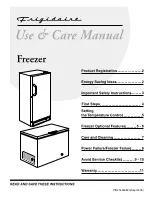
7
6
OPERATING INSTRUCTIONS
STORAGE
• Refrain from storing items to the full capacity of the appliance. Always allow adequate
space to ensure proper air cool air circulation and distribution.
• Do not store bottled or canned drinks below their freezing points to avoid frost cracks.
• Do not store any items not recommended by the manufacturer.
CARE & CLEANING
For hygienic reasons the appliance Interior, Including Interior accessories, should
be cleaned regularly.
To prevent the risk of electric shock, always unplug the power cord from the power
supply and remove all food contents inside the freezer before cleaning.
1. EXTERIOR & COOLING COMPARTMENT
Wipe with a damp and soft cloth. For soiled areas, apply a little mild detergent on the cloth
and wipe.
WARNING: Do not splash water directly onto the appliance and do not wash with
water as doing so may result in short-circuit and damage the appliance.
Important! Keep the appliance clean at all times. Never use organic solvents or
abrasive cleansing agents to clean as these may damage the finishing and plastic
parts upon contact.
2. DOOR
Detach the door and wipe with a damp, soft cloth.
IN THE EVENT OF
1. POWER FAILURE
Do not open the freezer door to prevent cool air from escaping. Cover the appliance with
a blanket or thick material will help maintain the appliance’s inner temperature. For long
power outage, place dry ice into the freezer compartment and avoid storing new items to
avoid raising the inner compartment’s temperature.
2. NOT USING FOR A LONG PERIOD
• Remove all food contents inside the appliance and disconnect the power plug from the
power supply.
• Clean the inner compartment and remove all traces of water.
• To prevent mold formation and malodor, leave the appliance door ajar completely before
covering with a plastic cover and storing in a cool, dry place.
PROBLEM
POSSIBLE CAUSES
NOTE: Operation may be affected if the appliance’s thermostat has been turned OFF.
No refrigeration at all
• Is power supply interrupted?
• Is the power plug disconnected from the power supply?
• Fuse may have been blown or circuit-breaker activated.
• Temperature control turned to MAX. If too cold, turn dial direction to OFF.
Inadequate refrigeration
• Inadequate ventilation where appliance is installed?
• Appliance exposed to direct sunlight or heat sources?
• Freezer door opened and closed frequently.
• Overstocked food items inside the freezer.
• Temperature control turned to MAX. If too cold, turn dial direction to OFF.
• Excessive frost inside the freezer compartment?
Excessive noise
• Appliance placed on unstable surface, resulting in rattling & vibrations.
• Rear panel may be in contact with wall or other surfaces.
• Loose part or object may be behind the appliance.
• A louder than normal sound can be heard during appliance startup – this
is normal.
Condensation on cooler exterior
• Condensation may form in the freezing compartment under hot & humid
conditions.
• This is normal as water particles condenses on the cool surface of the
freezer.
• Wipe condensation away using a soft cloth.
Exterior feels hot
• This is normal during appliance startup.
• An inner pipe inside the freezer radiates heat to prevent condensation
and protects the freezer’s contents.
CAUTION!
• Ensure power plug is disconnected from power supply and empty all contents
inside the freezer compartment before attempting to troubleshoot.
• Only a qualified electrician is able to perform troubleshooting not specified in
this user manual.
TROUBLESHOOTING






















